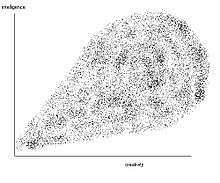Ellis Paul Torrance
Ellis Paul Torrance (October 8, 1915[1] – July 12, 2003) was an American psychologist from Milledgeville, Georgia.
After completing his undergraduate degree at Mercer University, Torrance acquired a Master's degree at the University of Minnesota and then a doctorate from the University of Michigan. His teaching career spanned from 1957 to 1984. First, he taught at the University of Minnesota and then later at the University of Georgia, where he became professor of Educational Psychology in 1966.
Torrance is best known for his research in creativity. His major accomplishments include 1,871 publications:88 books; 256 parts of books or cooperative volumes; 408 journal articles; 538 reports, manuals, tests, etc.; 162 articles in popular journals or magazines; 355 conference papers; and 64 forewords or prefaces.[2] He also created the Future Problem Solving Program International, the Incubation Curriculum Model, and the Torrance Tests of Creative Thinking.
Torrance Tests of Creative Thinking (TTCT)
Threshold Hypothesis
There has been debate in the psychological literature about whether intelligence and creativity are part of the same process (the conjoint hypothesis) or represent distinct mental processes (the disjoint hypothesis).
Evidence attempts to look at correlations between intelligence and creativity from the 1950s onwards, by authors such as Barron, Guilford or Wallach and Kogan, regularly suggested that correlations between these concepts were low enough to justify treating them as distinct concepts. Some researchers believe that creativity is the outcome of the same cognitive processes as intelligence, and that it is only judged as creativity in terms of its consequences, i.e.: when the outcome of cognitive processes happens to produce something novel, a view which Perkins has termed the "nothing special" hypothesis.

A very popular model is what has come to be known as "the threshold hypothesis", proposed by Torrance, which holds that, in a general sample, there will be a positive correlation between low creativity and intelligence scores, but a correlation will not be found with higher scores. Research into the threshold hypothesis, however, has produced mixed results ranging from enthusiastic support to refutation and rejection.
Legacy
In 1984, the University of Georgia established the Torrance Center for Creativity and Talent Development.
A special issue of Creativity Research Journal (guest edited by James C. Kaufman and John Baer) was dedicated to his honor and memory.The National Association for Gifted Children has designated a special lecture dedicated to Torrance in one of its focus interest groups.
Biography
- Torrance, E.P. (1974). Torrance Tests of Creative Thinking. Scholastic Testing Service, Inc.
- Millar, G.W. (2007). E. Paul Torrance, "The Creativity Man" : an Authorized Biography. ISBN 1-56750-165-6.
References
- "E. Paul Torrance Collection at Georgia College". Archived from the original on 2014-01-03.
- Spilman, Karen (2002). "E. Paul Torrance Papers, 1957-1967". The University of MinnesotaArchives.
External links
- Torrance Center for Creativity and Talent Development
- E. Paul Torrence papers, University Archives, University of Minnesota - Twin Cities